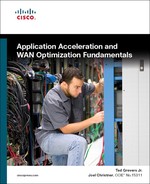Book Description
IT organizations face pressure to increase productivity, improve application performance, support global collaboration, improve data protection, and minimize costs. In today’s WAN-centered environments, traditional LAN-oriented infrastructure approaches are insufficient to meet these goals. Application Acceleration and WAN Optimization Fundamentals introduces a better solution: integrating today’s new generation of accelerator solutions to efficiently and effectively scale networks beyond traditional capabilities while improving performance and minimizing costs through consolidation.
Ted Grevers and Joel Christner begin by reviewing the challenges network professionals face in delivering applications to globally distributed workforces. You learn how accelerators are transforming application business models, enabling IT departments to centralize and consolidate resources while also delivering consistently superior performance.
Grevers and Christner show how to identify network consumers, prioritize traffic, and guarantee appropriate throughput and response times to business-critical applications. You learn how to use quality of service techniques such as packet classification and marking and traffic policing, queuing, scheduling, and shaping.
Next, you compare options for integrating accelerators and optimization services into your network and for optimizing content delivery. The authors show how to address application protocol-related performance problems that cannot be resolved through compression or flow optimization alone. In the final chapter, the authors walk you through several real-world scenarios for utilizing accelerator technology.
Ted Grevers, Jr., is the solution manager for the Cisco® Video IPTV Systems Test and Architecture (C-VISTA) team. He has extensive experience in the content delivery network (CDN) market, focusing on enterprise and service provider content delivery and application optimization needs.
Joel Christner, CCIE® No. 15311, is the manager of technical marketing for the Cisco Application Delivery Business Unit (ADBU). He has extensive experience with application protocols, acceleration technologies, LAN/WAN infrastructure, and storage networking. Grevers and Christner are key contributors to the design and architecture of Cisco application delivery and application acceleration solutions.
Provide high-performance access to remote data, content, video, rich media, and applications
Understand how accelerators can improve network performance and minimize bandwidth consumption
Use NetFlow to baseline application requirements and network utilization
Ensure network resources are allocated based on business priorities
Identify performance barriers arising from networks, protocols, operating systems, hardware, file systems, and applications
Employ application-specific acceleration components to mitigate the negative impact of latency and bandwidth consumption
Integrate content delivery networks (CDN) to centrally manage the acquisition, security, and distribution of content to remote locations
Leverage WAN optimization technologies to improve application throughput, mitigate the impact of latency and loss, and minimize bandwidth consumption
Optimize the performance of WANs and business-critical WAN applications
This book is part of the Cisco Press® Fundamentals Series. Books in this series introduce networking professionals to new networking technologies, covering network topologies, sample deployment concepts, protocols, and management techniques.
Category: Cisco Press/Networking
Covers: Network Optimization
Table of Contents
- Copyright
- About the Authors
- About the Technical Reviewers
- Acknowledgments
- Icons Used in This Book
- Foreword
- Introduction
- 1. Strategic Information Technology Initiatives
- 2. Barriers to Application Performance
- Networks and Application Performance
- Application and Protocol Barriers to Application Performance
- Operating System Barriers to Application Performance
- Hardware Barriers to Application Performance
- Summary
- 3. Aligning Network Resources with Business Priority
- 4. Overcoming Application-Specific Barriers
- 5. Content Delivery Networks
- Evolution of Content Delivery Networks
- Understanding CDN Solutions
- A Common Content Distribution Scenario
- Understanding CDN Components
- Managing a CDN
- Sharing the WAN
- Using Desktop Management Suites with Content Delivery Networks
- Using Centralized Network Settings
- Understanding Content-Serving Protocols
- Streaming Media Live or On Demand
- Authenticating Requests for Prepositioned Content
- Acquiring Content
- Understanding CDN Distribution Models
- Understanding Time-of-Day Distribution
- Understanding Software-Based Content Delivery Networks
- Understanding Explicit and Transparent Proxy Modes
- Using CDN Calculation Tools
- Summary
- 6. Overcoming Transport and Link Capacity Limitations
- Understanding Transport Protocol Limitations
- Understanding Transmission Control Protocol Fundamentals
- Overcoming Transport Protocol Limitations
- Overcoming Link Capacity Limitations
- Summary
- 7. Examining Accelerator Technology Scenarios
- A. Common Ports and Assigned Applications
- B. Ten Places for More Information
- 1: Cisco IOS Technologies
- 2: Cisco Product Documentation
- 3: NetQoS Network Performance Management Tools
- 4: BIC TCP
- 5: Low Bandwidth File System
- 6: Locating a Request for Comment
- 7: Microsoft TechNet
- 8: Hewlett-Packard Product Documentation
- 9: Red Hat Product Documentation
- 10: Registered TCP and UDP Port Numbers
